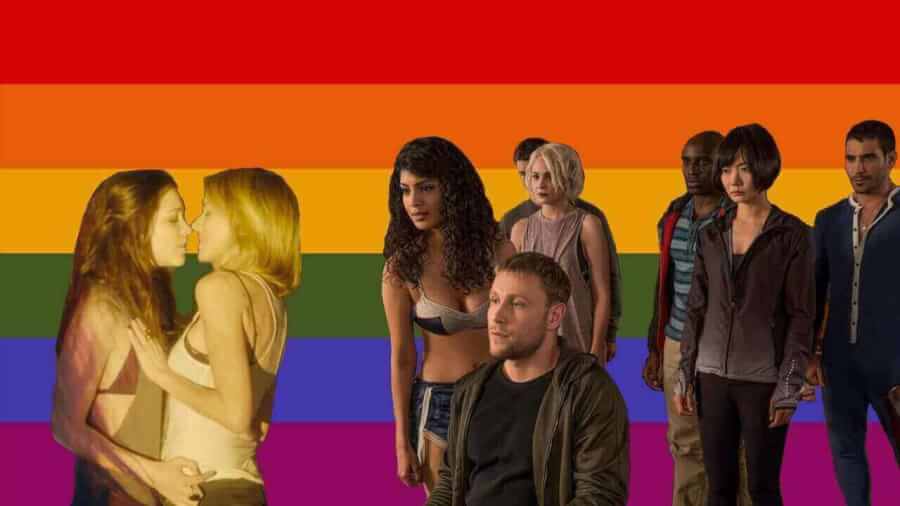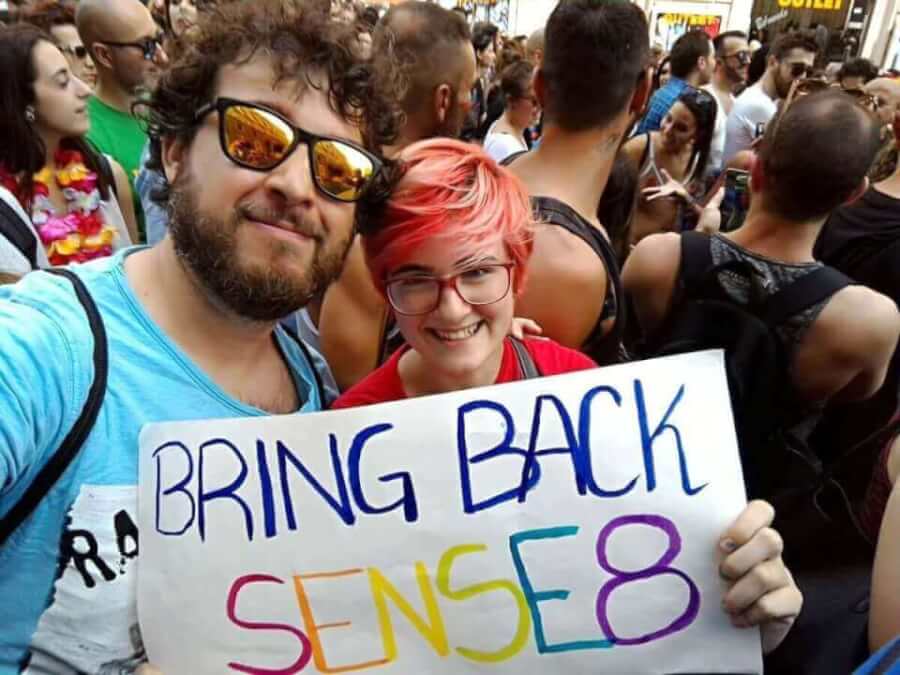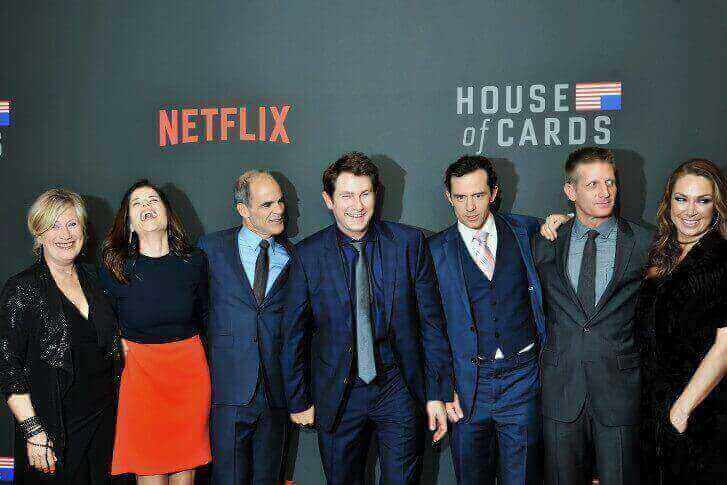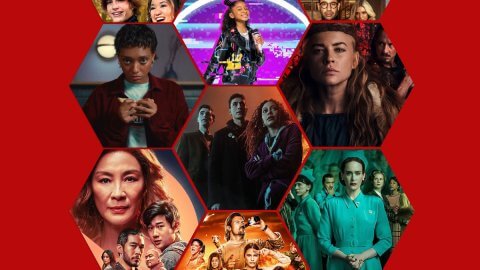
“Invisibility is indivisible from visibility” and if recent Netflix cancellations are anything to go by, the streaming network’s LGBT centric shows are disappearing into the ether faster than viewers can keep abreast with the development. This is not an emerging trend; instead, it appears to be company policy since the network has unceremoniously canceled a slew of its most critically acclaimed LGBTQ showpieces since last June.
Remember Gypsy? And The Get Down created by Baz Luhrmann? Perhaps not, as Everything Sucks become the latest pro-LGBTQ series to face the axe and dominate the headlines and twitter feeds. When the network’s LGBT signature piece Sense8 was cancelled nearly a year ago, on the first day of pride month no less, there was outrage and a public outcry which secured a two hour special episode to wrap up the series but the cancellation of LGBT shows have become too commonplace to warrant a similar reaction as audiences struggle to keep track of what’s streaming today and cancelled the next day when it comes to LGBTQ centric programming. Which is concerning as Netflix, ironically, produces a large number of LGBTQ oriented shows each year only to cancel them after the first or second season.
A sign of the times perhaps? Why does the largest internet streaming company in the world fail to renew LGBTQ oriented series year after year? And what does it say about the future of the streaming giant and its reputation with the community which bears the brunt of this very public alienation?
Trendsetter
There’s little doubt that Netflix has been a trendsetter when it comes to how we consume media and the availability and access to entertainment from television series to movies across platforms. Unfortunately, Netflix is also fast becoming a network with a fear of commitment to LGBTQ content. The network’s cancellations and renewal policy is an equally murky area as Netflix does not release viewer metrics, the same way a cable network such as HBO or a channel the likes of NBC, who owe both the media and stockholders a record of its ratings and data pertaining to viewership. Game of Thrones is the most watched television show on the planet. This is fact. It’s a fact because HBO releases viewer metrics for the fantasy series, unlike Netflix.
The Verge called out Netflix as early as 2013 on this special privilege, criticising how the network “refuses to reveal any hard viewership numbers. Without a challenge from Wall Street or the media, the company can call any of its five original TV series a hit, just so long as the shows, which include House of Cards, Lilyhammer, and Arrested Development, meet some vague set of benchmarks set by Netflix management… Sarandos suggested that everyone should be satisfied that these Netflix originals are hit shows because people are “talking about them in Starbucks”. With coffee shop conversations determining the hit worthiness of a Netflix original, it is amusing to consider which of these canceled TV series failed to make for a hot topic at the coffee shop as no reasons were offered for the cancellation of the series except for their alleged lack of high viewership numbers. Now that’s symmetry folks.
Beyond Buzz Words
There was a time when the Jackie Chang and Chris Tucker starring blockbuster Rush Hour was praised as a groundbreaking feat in the name of diversity. A buddy cop movie featuring two minorities as leads broke Hollywood standards of what constitutes a successful comedic duo. There was not a single white male in sight and the franchise is one of most lucrative brands in film entertainment to date.
The canceled LGBTQ oriented content also falls into this category, unlike most mainstream television shows which feature, gay, lesbian, bisexual and transgender characters as sidekicks or as supporting roles for a straight, white lead, with little to no subplots to call their own. There are numerous LGBT characters in many “hit” Netflix shows but the depth and the authenticity of said characters rarely go beyond semantics or the “bury your gay” trope as gayness or gender identity are used to add colour and depth to an otherwise dull minor character who has no significant role in the overall plot except to prop up the main lead. GLAAD’s yearly Where We Are on TV report last November echoed this sentiment as it found ““LGBTQ characters remain largely on the fringes of ensemble casts, rather than the leads of the series…As such, their screen time tends to vary based on how many plots the overall series has time to handle. It is then easier to treat this character as expendable – either killing them off when in need of a buzzy shock or otherwise writing the character off.”
The Netflix Originals that were put out to pasture featured LGBTQ characters as leads and placed the struggles and triumphs of the LGBT experience at the forefront of the narrative arc. How can many “LGBTQ friendly” hit shows on Netflix boast a same-sex lovemaking scene in the very first episode or are shot at pride festivals around the world as in the case of Sense8? Characters of Netflix’s growing number of castaway shows are not token members of the LGBTQ community or stereotypes but three-dimensional explorations of the complexity of what is means to be a non-binary individual in a binary world.
Marketing Inequity
Perhaps, it really is about the numbers as Netflix attests but why haven’t these LGBTQ centered series found its target audience? Maybe the answer also lies in another set of numbers. Like the cost of Netflix’s 2017 Superbowl commercial for Stranger Things Season 2 or the number of Stranger Things t-shirts and merchandise sold in Target? Or the number of times the cast of the popular sci-fi series or teen drama 13 Reasons Why and Netflix darling The Crown have appeared on late night talk shows such as Jimmy Fallon, Jimmy Kimmel and Late Show with Stephen Colbert or made appearances on daytime chat shows such as Ellen. Having been a fixture on the Netflix line-up since 2015 and the only LGBT centric show to secure a second season, Sense8 has two Facebook live chats and an hour-long Google hangout session via Skype to its name to date as far as marketing is concerned. Gypsy and Everything Sucks were canceled three months and one month respectively after the shows were released so understandably there was no time for one-on-one’s with the cast of the canceled shows even if they included Academy Award nominee Naomi Watts and Tony Award winning Billy Crudup.
The swiftness of the cancellations soon after the release of a new series also begs the question of whether a month or two is sufficient time for a television show to find its audience, especially in a streaming network which premiers hundreds of new shows and films on its platform each month. And how realistic are expectations that a series without a marketing strategy will secure a significant portion of the audience to warrant a second or third season when it’s canceled weeks after its release date?
While Netflix shows such as Stranger Things and House of Cards are easily identified with the network, there are hundreds of viewers; LGBT community member included who have yet to hear of Sense8, Gypsy, The Get Down or Everything Sucks. As American Netflix subscriber Geri Hertel describes “I have been a subscriber to Netflix since 1997 when Netflix sent DVD’s through the mail, the fact that I did not hear aboutSense8 until 2018 is outrageous. Netflix heavily promoted Stranger Things, and I have seen both seasons. My friends knew about Stranger Things but not Sense8 or Gypsy, Netflix had links on their site to navigate me to watch mainstream shows. The same could have been said about Sense8, but sadly that was not the case. I don’t understand why Netflix doesn’t place links to a wider range of shows on their Splash Page.” The social media pages for the canceled LGBT shows also tell a similar story of low engagement with its audience and general disregard for fans and followers unlike the social media accounts of mainstream programs which have a more interactive relationship with fans.
Force Stop Narratives
With a collection of incomplete and canceled LGBTQ shows growing by the month leads to the larger issue of what these force stop narratives mean for the streaming network regardless of the nature of the content. How many times will viewers invest their time in a new Netflix Original only to have it canceled a month later? In a climate where television networks renew shows for two or more seasons in a single year, Netflix’s haphazard cancellation policies have placed viewers in quite an uneasy conundrum. Having once earned the reputation as the network that will revive anything, from decades-old TV shows such as Full House to Gilmore Girls, Netflix now faces a new challenge of convincing an increasingly disgruntled viewership that suspects the company’s commitment to the completion of its original content. And while the argument of canceled series still being available for streaming is valid, how many new viewers will be compelled to watch a canceled series with a single season or two to its name?
The Missed Opportunity

Credit: https://twitter.com/feliciawhy
The truly disconcerting element of these cancellations and the message it sends to the viewing public and the LGBTQ community at large is that it is an expendable minority when the truth is quite the opposite. The LGBTQ television consumer demographic is one that’s on the rise and one that is increasingly vocal and specific regarding what their preferences are with regards to entertainment. Then why are these series not marketed or reaching the intended audience? Perhaps it is because Netflix is becoming an entertainment conglomerate that saturates the market with new content for the sake of novelty but fails to see the social impact and capacity for real change available in each of their creations. In a world where being a gay, lesbian, transgendered individuals runs the risk of being subject to conversion therapy, imprisonment, and execution, the significance of eradicating homophobia and feelings of “otherness” through art and progressive programming can be paradigm shifting and life-saving.
As transgender YouTuber Vincent of VincentViews puts it “Representation is so important because of all the young LGBT people growing up… If all they see is straight people, they’ll think they’re not normal, they’ll think they’re wrong. If they see another LGBT person on the TV they can identify with then maybe, just maybe, they’ll feel like they belong in this world; that they aren’t broken and there’s nothing wrong with who they are.”Queer content not only empowers and validates the LGBT community, it can also make a lasting impact on the would-be perpetrators of homophobic crimes and propel other members of the straight community to have a more accurate understanding of what it means to be LGBTQ and blur the lines of self- imposed separation.
While we all know the business of entertainment is just that, a business first, its responsibility and capacity to raise a generation that not only doesn’t see race or ethnicity but also sexual and gender orientation cannot be underestimated as we all need mirrors to tell us we are here and that we matter.
Editors Note: This is an opinion piece.







